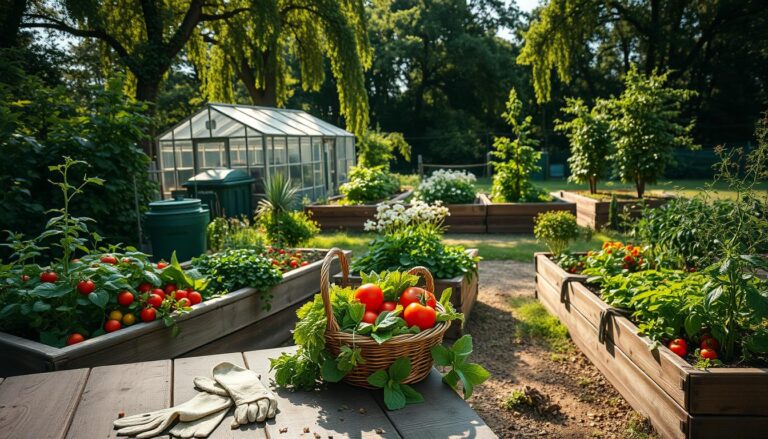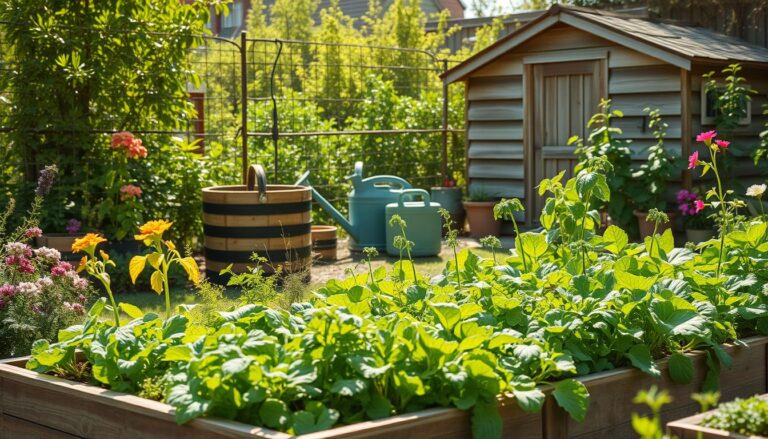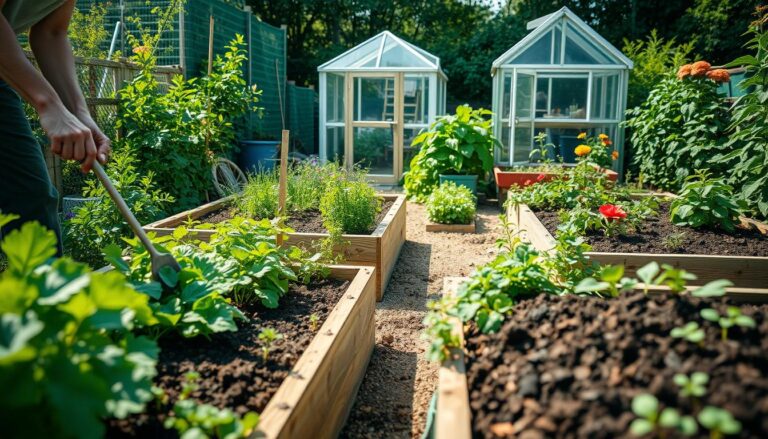Starting eco-friendly gardening in your backyard is rewarding. It lets you care for nature right at home. By using green techniques, you can make a garden that’s beautiful and helps the planet.
This guide will show you how to garden in a way that’s good for the earth. You’ll learn how to make your garden better for both you and the planet. With a few easy steps, you can help the environment a lot.
What is Sustainable Gardening?
Sustainable gardening is about making a balance between nature and our gardens. It uses organic gardening techniques to lessen harm to the environment and boost biodiversity.
It’s more than just growing plants. It’s about making a space that helps both the gardener and the planet. By following environmentally friendly gardening tips, we can help make the Earth healthier.
Definition and Importance
Sustainable gardening means growing plants in a way that saves natural resources and cuts down on waste. It aims for ecological balance. This is key for a smaller ecological footprint and a sustainable future.
It’s vital for the planet. Using organic gardening techniques helps avoid harmful chemicals. This protects the soil and keeps water clean.
| Benefits | Description |
|---|---|
| Environmental Conservation | Reduces pollution and conserves natural resources |
| Biodiversity Promotion | Supports local ecosystems and wildlife |
| Resource Efficiency | Minimizes waste and optimizes water usage |
Key Principles of Sustainability
The main ideas of sustainable gardening include using native plants, saving water, cutting down on waste, and avoiding harmful chemicals. By following environmentally friendly gardening tips, like composting and using rainwater, we can lessen our impact on the environment.
It needs a complete view of gardening, thinking about how our actions affect the planet. For example, native plants need less care and help local wildlife.
Benefits of Sustainable Gardening
Sustainable gardening has many benefits, from saving the environment to improving your health. By using green gardening methods and sustainable landscaping ideas, you help the planet and feel better too.
Environmental Advantages
Sustainable gardening is great for the environment. It offers several key benefits:
- It saves water with smart irrigation systems
- It cuts down pollution with organic fertilizers and pest control
- It protects wildlife by planting native plants and keeping ecosystems balanced
| Environmental Benefit | Description |
|---|---|
| Water Conservation | Uses water wisely with drip irrigation and rainwater harvesting |
| Pollution Reduction | Uses natural and organic products to lower chemical pollution |
| Biodiversity Protection | Plants native species and creates homes for local wildlife |
Personal Well-being
Sustainable gardening is good for you too. It can:
- Lower stress and boost mental health
- Give you physical exercise and better health
- Make you feel accomplished and connected to nature
By gardening sustainably, you get a rewarding experience and help the planet.
Choosing Native Plants for Your Garden
Using native plants in your garden makes it look better and helps local wildlife. These plants fit well with the local weather and soil. They are easy to care for and good for the planet.
Why Native Plants Matter
Native plants are key to keeping nature in balance. They give food and shelter to local animals like bees and birds. This is vital for a healthy environment. Plus, they need less water and care, which is better for the earth.
By picking native plants, you help keep your area’s natural beauty alive. These plants are part of the local ecosystem. Keeping them around helps keep nature diverse.
Best Native Plants for Different Regions
Native plants differ by region because of different weather and soil. Here’s a quick look at some good native plants in the U.S.:
| Region | Native Plants | Benefits |
|---|---|---|
| Northeast | Black-eyed Susan, Joe-Pye Weed | Attracts pollinators, drought-tolerant |
| Southwest | Desert Marigold, Texas Sage | Low water requirements, attracts birds |
| Pacific Northwest | Oregon Sunshine, Western Buttercup | Thrives in moist soils, supports local bees |
For more info on native plants for your area, check out local gardening tips or visit a native plant nursery.
Adding native plants to your garden is a simple yet powerful way to garden naturally. It makes your garden look great and helps your local environment too.
Soil Health and Management
Healthy soil is key to a thriving garden. It supports plant growth and keeps your garden productive. By using sustainable horticulture strategies, you can make your soil better.
Composting Basics
Composting is a basic part of gardening. It turns waste into a soil that helps plants grow. You need green and brown materials to start.
Key Composting Tips:
- Maintain a balance between green and brown materials.
- Ensure adequate moisture and aeration.
- Monitor temperature to optimize decomposition.
Cover Crops and Their Benefits
Cover crops are important for soil health. They protect the soil, fight weeds, and attract good insects. Legume cover crops, for example, add nitrogen, cutting down on synthetic fertilizers.
| Cover Crop | Benefits | Climate Suitability |
|---|---|---|
| Clover | Nitrogen fixation, weed suppression | Temperate climates |
| Rye | Erosion control, soil health improvement | Cool-season climates |
| Buckwheat | Weed suppression, attracts beneficial insects | Warm-season climates |
Composting and cover crops improve your soil. These sustainable horticulture strategies help your garden and the environment.
Water Conservation Techniques
Water conservation is key in eco-friendly gardening. It keeps your garden healthy and eco-friendly. Using water wisely saves water and money, making gardening better for the planet.
There are many ways to save water in your garden. We’ll look at two great methods: rainwater harvesting and drip irrigation systems. Both help use less water and make your garden healthier.
Rainwater Harvesting
Rainwater harvesting collects and stores rainwater for your garden. It cuts down on groundwater and city water use. This saves money and helps protect water resources.
- Reduces stormwater runoff and erosion
- Provides a free source of water for irrigation
- Decreases the burden on municipal water supplies
Drip Irrigation Systems
Drip irrigation systems send water straight to plant roots. This cuts down on evaporation and runoff. It makes sure plants get the water they need without wasting any.
Benefits of Drip Irrigation:
- Reduces water loss through evaporation and runoff
- Promotes healthy plant growth by delivering water directly to the roots
- Can be more efficient than traditional sprinkler systems
| Technique | Water Savings | Implementation Cost |
|---|---|---|
| Rainwater Harvesting | Up to 50% | Moderate to High |
| Drip Irrigation Systems | Up to 30% | Low to Moderate |
Integrated Pest Management (IPM)
Gardening sustainably is more than picking the right plants. It also means managing pests wisely, which is what Integrated Pest Management (IPM) is all about. IPM looks at your garden’s whole ecosystem. It aims to protect good bugs and the environment.
“The goal of IPM is not to get rid of pests completely,” says a top expert in green gardening. “It’s about managing them in a way that’s safe for the environment and people.” This method uses different techniques to control pests, cutting down on chemical pesticides.
Understanding IPM Principles
IPM is built on a few key ideas. First, you need to know who the pest is and how it lives. Then, you should know its natural enemies. This helps gardeners pick the best ways to manage pests.
Crop rotation is a good example. It can stop pests from coming back by breaking their life cycle.
- Monitoring pest populations regularly
- Setting action thresholds to determine when control measures are needed
- Choosing the most effective management strategies
- Evaluating the effectiveness of those strategies
By sticking to these principles, gardeners can fight pests without harming the environment.
Natural Pest Control Methods
At the heart of IPM are natural ways to control pests. This includes bringing in good bugs like ladybugs or lacewings to eat pests. Physical barriers, like mesh or netting, can also keep pests away from plants.
Keeping your garden clean is another key method. Getting rid of weeds and trash makes it harder for pests to hide. Plus, growing plants together that keep pests away is a smart move.
By mixing these natural methods with IPM knowledge, gardeners can make their gardens healthy and balanced.
Organic Fertilizers: The Healthier Choice
Sustainable gardening is not just about the plants you pick. It’s also about how you feed them. Organic fertilizers are key to healthy plant growth and eco-friendly gardening.
Organic fertilizers come from natural sources like compost, manure, and green sand. They give nutrients slowly, making soil better over time. This slow release helps plants get nutrients steadily, avoiding too much fertilizer.
Types of Organic Fertilizers
There are many organic fertilizers to choose from, each with its own benefits. Compost is a favorite, made from broken-down organic stuff. It’s full of nutrients and helps soil hold water better.
- Manure: It’s full of nutrients, but needs to be aged or composted to avoid harming plants.
- Green Sand: Made from rock, it’s a slow-release fertilizer that gives potassium and other nutrients.
- Bone Meal: It’s high in phosphorus, great for roots and flowers.
How to Fertilize Sustainably
Fertilizing sustainably means more than just using organic fertilizers. It’s also about how you use them. Gardeners should test their soil to know what nutrients it needs and its pH level.
When using organic fertilizers, follow the recommended amounts to avoid harming plants and the environment. Also, timing is key. Fertilize when plants need it most, usually during the growing season.
By using these sustainable fertilizing methods, gardeners can grow a healthier garden. This garden supports local wildlife and reduces harm to the environment.
Creating a Wildlife-Friendly Garden
A wildlife-friendly garden is more than a home for local species. It’s a key part of eco-friendly gardening. By making such a garden, you support biodiversity and boost your outdoor space’s ecological value.
Creating a wildlife-friendly garden means supporting biodiversity. This means making a home for many plants and animals. Here’s how to do it:
Importance of Biodiversity
- Adding more plants attracts more wildlife.
- Native plants are key as they feed and shelter local species.
- Steering clear of chemical pesticides and fertilizers keeps the ecosystem healthy.
Biodiversity is key for a strong garden ecosystem. It keeps your garden lively and strong, even when faced with tough environmental times.
Providing Habitat for Pollinators
Pollinators like bees and butterflies are vital for many plants. To help them, follow these steps:
- Grow a mix of flowers that are full of nectar and pollen.
- Make sure there are safe spots for pollinators to nest and lay eggs.
- Don’t use pesticides that can harm or kill pollinators.
Experts say, “Gardens that help pollinators greatly boost local biodiversity and ecosystem health.”
“Gardens are not just beautiful; they’re also vital homes for many species. By making our gardens friendly to wildlife, we can have a big positive effect on the environment.”
By following these tips, you can make a garden that’s great for wildlife. It will also help you connect more with nature.
Seasonal Gardening Tips
The secret to a great garden is to follow nature’s cycles and adjust your gardening as the seasons change. This way, your garden thrives and helps the planet through green gardening methods.
Planting in Harmony with Seasons
It’s important to plant at the right time for your garden to do well. Choose plants that match the season and your local weather. For example, spring is perfect for cool-season crops like broccoli and kale. Summer is better for warm-season crops like tomatoes and peppers.
- Spring: Plant cool-season crops and start seedlings for warm-season crops.
- Summer: Keep the soil moist, fight weeds, and pick warm-season crops.
- Autumn: Plant cool-season crops again and get ready for next year.
- Winter: Plan for next season, protect soil, and keep your garden in shape.
Sustainable Practices Year-Round
Using sustainable gardening all year is key for a healthy garden. This means mulching to keep soil moist, composting to make soil better, and using cover crops to stop erosion and make soil richer.
- Mulching: Keeps moisture in, stops weeds, and controls soil temperature.
- Composting: Makes soil better with nutrients, improving its health and fertility.
- Cover Cropping: Keeps soil from washing away, adds organic matter, and draws good bugs.
By adding these practices to your gardening, you’ll have a lively and eco-friendly garden all year. This follows the seasonal gardening way.
Community Involvement in Sustainable Gardening
Working together is key to promoting sustainable gardening. People can share knowledge and resources to help the environment.
Gardening Resources for the Community
Joining local gardening groups is a great way to get involved. These groups offer workshops, webinars, and forums. For example, the National Gardening Association has lots of info on sustainable gardening.
Organizing Community Projects
Starting community garden projects is another good idea. Working with locals, organizations, and businesses can create green spaces. These projects help build community and care for the environment.
FAQ
What is sustainable gardening, and why is it important?
How can I make my garden more eco-friendly?
What are the benefits of using native plants in my garden?
How can I improve soil health in my garden?
What are some effective water conservation techniques for gardening?
How can I manage pests in my garden without using chemical pesticides?
What are the advantages of using organic fertilizers in my garden?
How can I create a wildlife-friendly garden?
What are some sustainable gardening practices I can adopt year-round?
How can I get involved in community gardening initiatives?

Sortemdia nasceu com o propósito de trazer alegria e oportunidades para todos por meio de sorteios gratuitos de prêmios incríveis. O site tem como missão oferecer experiências acessíveis, divertidas e justas para quem deseja concorrer a produtos, serviços e brindes sem pagar nada por isso. Acreditamos que a sorte pode bater à porta de qualquer pessoa — e no Sortemdia, ela pode chegar com apenas um clique.



